The air duct performs an important function of removing contaminated air masses from the room. It is recommended to arrange thermal insulation to extend its operating time and increase the efficiency of drainage. You can make an insulated air duct in different ways using different materials.
The need for insulation of the ventilation system
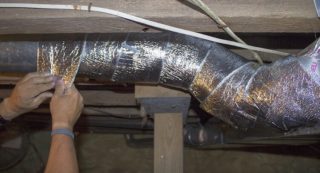
Ventilation is the most important element in the house, ensuring that the air in the room meets the sanitary and hygienic standards. In the process of life, a person releases a lot of moisture from cooking, washing, cleaning and other household chores. The air also contains combustion products, odors, dust and other pollutants that are harmful to human health. They are removed by ventilation and its elements, such as an extractor hood.
Creation of thermal insulation of air ducts allows to increase the quality of ventilation due to the faster movement of contaminated air masses upward. Insulation protects the outer surface of the room from condensation, which damages the structure and floors. The main goal is for the dew point to fall into the insulation for ventilation, and not on the walls.
The choice of insulation
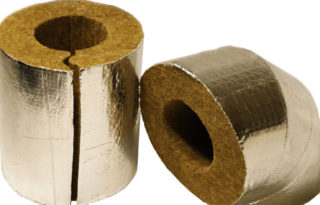
There are different materials with which you can insulate the ventilation duct. The most popular are:
- Minvata. It is a natural, eco-friendly, durable material with good UV resistance. Sold as mats of various thicknesses. Not used at high temperatures. Mineral wool is required to be covered with a casing on top to avoid moisture ingress on it. It is suitable for use in well-assembled ventilation ducts, except for supply ventilation. The most important disadvantage is contamination with fine glass threads during assembly work.
- Basalt wool. Resistant to aggressive environments and high temperatures, not afraid of ultraviolet radiation. Not flammable. Produced in the form of mats, plates, shells for insulated ventilation pipes. It absorbs moisture, which is a serious disadvantage.
- Foamed polyethylene. This is the cheapest insulation. Available in sheets up to 10 mm thick, bundles and shells. May have a foil surface. Advantages - does not absorb moisture, durable, plastic. Subject to burning, unstable to high temperatures and ultraviolet rays.
- Expanded polystyrene. There are different types - expanded and extruded, or extrusion (penoplex). The latter is an improved type that does not absorb moisture and does not allow steam to pass through. Long lasting, high temperature resistant. The disadvantages include high cost. Most often it is used for insulation of ventilation ducts.
- Asbestos boards. They have low thermal conductivity, are resistant to temperatures up to 400 ° C and ultraviolet rays, do not absorb water. It is not used inside buildings due to harm to the body.
- PIR plates. This is the latest material with good perspectives. It is a rigid material with closed cells, low thermal conductivity, UV and moisture resistance. Does not burn. Service life exceeds 50 years. It is not yet widespread for insulation of ventilation ducts, therefore, a high price can be distinguished from the disadvantages.
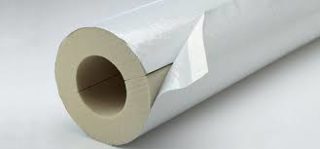
The choice of material is determined by the requirements for it.Insulation should be of high quality, inexpensive and easy to install. The most promising material for insulated pipes for ventilation are PIR plates, but they cannot be used on a round duct.
Difficulties in installation and operation arise when using mineral wool. It absorbs moisture and crumbles. It is forbidden to use asbestos in thermal insulation of ventilation ducts, as it is carcinogenic.
Penofol or rubber can be used at joints and turns. But it must be borne in mind that it will take several layers for thermal insulation of the air ducts. The price is above average.
The best choice in terms of price and quality ratio is extruded polystyrene foam. But due to its low strength, duct insulation should be used where it will not be touched (for example, an attic or basement).
Thermal insulation
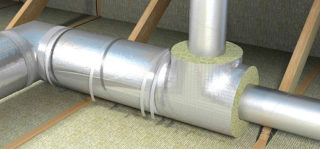
Proper insulation includes several basic requirements:
- All insulating materials must fit snugly against the pipes. The best option is to insulate the ventilation ducts in the form of a shell for pipes that correspond to the diameter. Each layer must be securely and tightly fixed so that there is no sagging in any place.
- Inside the house, it is necessary to insulate the supply ventilation duct, which is also called negative temperature and fan pipes. A vapor barrier layer is also required. Fastening is done on clamps, wire, aluminum tape, special glue.
- Pipes in the attic and in the basement are sure to be insulated.
- For outdoor insulation, a layer of thermal insulation with UV protection is required.
The hood is insulated from the same materials as the ventilation insulation. Due to the low temperature, there is practically no risk of fire, therefore there are no special requirements for combustibility.
Expert advice
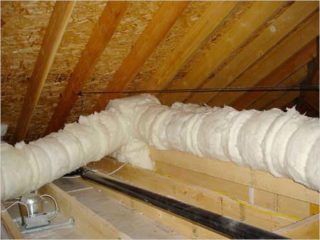
Basic recommendations for insulation of ventilation ducts:
- When insulating in the open air with mineral wool, the creation of high-quality waterproofing is required. For this, roofing material can be used.
- In the case of using shells made of EPS or polyurethane foam in a dark room (basement, attic), the top cover layer can be omitted.
- Plastic insulators must not be attached to bitumen or bitumen primer. It disturbs the structure, which can cause the shell to crack.
- Particular attention is paid to waterproofing the place where pipes pass through the roof. It is here that all condensation accumulates, so it is important to protect the place. A master flash is suitable for waterproofing the unit.
- It is important to pay attention to the thermal insulation of cold supply ventilation blowers before entering the house. Sections of air supply pipes to the boiler or fireplace are also insulated. The exception is coaxial chimneys.
You can make high-quality insulation with your own hands. It is only important to choose the right material and tools, and then make thermal insulation according to the instructions.








